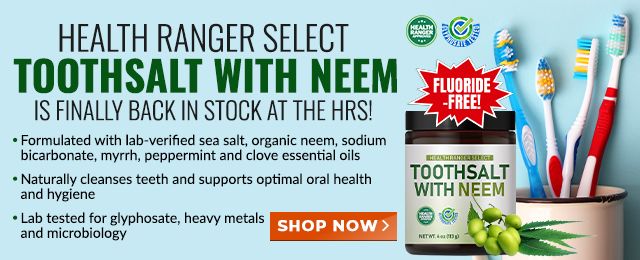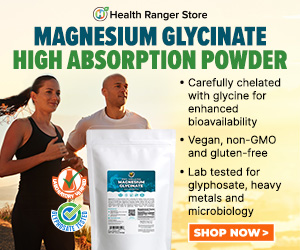
Ultraviolet B (UVB) Radiation Reduces Risk of 16 Types of Cancer in U.S. (press release)
Monday, October 02, 2006 by: NewsTarget
Tags: health news, Natural News, nutrition
- Oncologist warns of ‘terrifyingly aggressive’ cancers in children, linked to immune suppression from COVID vaccines
- NIH study, buried for decades, reveals that Flu Shots INCREASE elderly deaths, not prevent them
- COVID-19 scandal linked to CANCER SURGE: Billionaire researcher sounds alarm
- Musk targets “strangely wealthy” lawmakers in DOGE probe, names Pelosi, McConnell, Schumer
- Health Ranger Report: Ashton Forbes discusses TELEPORTATION ORBS and their role in MH370 disappearance
- Trump administration CUTS FUNDING to Gavi, the Vaccine Alliance - a major blow to the Bill Gates-backed entity
- Ancient kitchen secrets REVEALED: How garlic, ginger and green onions fight cancer and heart disease
- DARPA: The shadowy innovator behind the world’s most advanced military technologies
- Millionaire fitness coach charged in Tesla vandalism incident as anti-Musk attacks escalate
- “Ethically sourced” human “bodyoids” could usher in a new era of medical exploitation, raising disturbing ethical questions
- Newly released JFK files reveal Pentagon's role in creating Lyme disease and covid in the same lab
- European Court of Justice: Healthcare professionals who promoted or administered COVID-19 vaccines are CRIMINALLY LIABLE for any harm caused
- Britain’s descent into police state censorship: Parents raided for questioning their daughter’s school system online
- RFK Jr. is pushing Big Pharma ad ban - and corporate media is panicking
- EPA banned chemical linked to cancer, Parkinson's and fatal heart defects in babies - now industry is lobbying to get it reinstated
- Tackling the rubber waste crisis: Groundbreaking study reveals eco-friendly method to recycle tires
- Homesteading Boom: How families are escaping cities to grow their own food
- Joseph Farrell’s “The Cosmic War”: Did an interplanetary conflict reshape the solar system?
- Newly released JFK files reveal Pentagon's role in creating Lyme disease and covid in the same lab
- CDC finally halts $11 billion COVID funding scam as health officials admit the ‘pandemic’ was a fraud
- Analysis: The coming economic collapse, a mass uprising and Trump's three secret weapons to halt the growing revolt
- Kiss Your Genetic Privacy Good-Bye! 23andMe Gets Green Light to Sell Your Intimate Genetic Details to Anyone They Want
- Dr. Suzanne Humphries makes bombshell appearance on Joe Rogan podcast, exposing vaccine industry deception back to POLIOMYELITIS
- DEADLY DECEPTION: How COVID vaccines increased mortality rates and why authorities hid the truth
- Woman contracts WORLD'S DEADLIEST VIRUS after unknowingly being given the WRONG VACCINE
- Oncologist warns of ‘terrifyingly aggressive’ cancers in children, linked to immune suppression from COVID vaccines
- Here are TEN all-natural ways to protect your garden without using harmful chemicals
- Black cumin seed oil emerges as a powerful ally against breast cancer and chronic inflammation
- The hidden dangers in your kitchen: How cooking methods impact diabetes, cancer and aging
- Trump's greatest betrayal so far: Accelerating Middle East wars, silencing dissent, and serving Zionist masters
- Senate Democrats deny censorship industrial complex existed, defend government's role in silencing dissent
- Sugar-free deception: Artificial sweeteners hijack hunger signals, fuel obesity epidemic, study warns
- “Independent” anti-Russia outlet MEDUZA faces COLLAPSE as US funding dries up
- NIH study, buried for decades, reveals that Flu Shots INCREASE elderly deaths, not prevent them
- The Health Ranger releases “Vaccine Zombie” song and music video, using AI-animated zombies for the music video
- Discovery of vast underground city beneath Giza pyramids challenges human history
- Newly released JFK files reveal Pentagon's role in creating Lyme disease and covid in the same lab
- California's social media censorship law struck down: A victory for free speech or a threat to online safety?
- EPA advisor admits the agency is funneling billions to climate groups ahead of Trump’s return to White House
- The Health Ranger releases “Vaccine Zombie” song and music video, using AI-animated zombies for the music video
- Dr. Mike Yeadon releases 15-minute testimony - WATCH - about genocidal intent of COVID “vaccines”
- Florida takes a stand: DeSantis proposes permanent ban on mRNA vaccine mandates
- Mike Adams releases country western hit single: Goin’ Back in Time is Comin’ Home
- “Why we influenced the 2020 elections”: Facebook files reveal the coordinated effort to bury the Hunter Biden laptop story
- Unpacking the Lies That We’ve Been Fed – new song and music video released by Mike Adams, the Health Ranger
- House Intelligence Committee calls for the ARREST and PROSECUTION of Dr. Anthony Fauci
- The pandemic as a tool for INDOCTRINATION: Understanding “The Indoctrinated Brain” by Dr. Michael Nehls
- Rep. Nancy Mace introduces bill to ban biological males from female facilities on federal property
- Mike Adams releases music poetry sensation: A Child of God
- Sugarcane extract superior to cholesterol-lowering drugs?
- Survival 101: Effective EMF blocking techniques
- Michigan sheriff announces criminal investigation into 2020 election crimes, Dominion Voting Systems
- Peter Rost exposes Big Pharma corruption in his book “The Whistleblower: Confessions of a Healthcare Hitman”
- Migrants are taking advantage of recent hurricanes to scam residents and loot their homes
- Red Cross issues warning to stop blood plasma donations from vaccinated people
- Scientists confirm: GENIUS brain function can be spontaneously unleashed in humans without any apparent cause
- EPA advisor admits the agency is funneling billions to climate groups ahead of Trump’s return to White House
- HYSSOP: What research reveals about the health benefits of this ancient holy herb
- Two containers with completed ballots fall out of truck in Florida
- Fully vaccinated about to see “tsunami” of illness and death, warns virologist
- Global leaders unite to clamp down on “misinformation” with UN-backed Cascais Declaration
- BREAKING: 2025 NDAA authorizes mandatory military draft of WOMEN across America… as Pentagon pursues global NUCLEAR war with both Russia and China at the same time
- Michael Yon warns of a ZIONIST TAKEOVER in Trump’s second administration
- BOMBSHELL: DNA testing kits are a SCAM to develop ethnic-specific bioweapons
- Ozempic and Wegovy weight loss drugs are injectable LIZARD VENOM PEPTIDES that may unleash a devastating wave of organ failure… side effects align with symptoms of SNAKE BITES
- Israeli soldiers accused of even more torture and abuse in the West Bank
- These 13 countries just signed an agreement to engineer a global FAMINE by destroying food supply
- NASA admits that climate change occurs because of changes in Earth’s solar orbit, and NOT because of SUVs and fossil fuels
- RFK Jr. clears key hurdle: Sen. Susan Collins backs controversial HHS nominee, signaling a new era for health policy
- Sermon 30: How Jesus reveals Caesar’s FAKE CURRENCY and FALSE AUTHORITY
- Coriander seeds: Ancient medicine backed by modern science
- Arizona officials claim Maricopa County needs 10-13 days to tabulate results of the election
The analysis examined age-adjusted mortality rate data from 49 states plus the District of Columbia for two periods: 1950-69 and 1970-94. Other cancer risk-modifying factors were included in the analysis. A proxy indicator of smoking was associated with risk at 10 cancer sites, alcohol consumption with 9 sites, urban residence with 7, and Hispanic heritage with 6.
“This study provides important additional support for the vitamin D/cancer hypothesis” according to William Grant. This new study shows that the approach used, a statistical comparison of cancer mortality rates by state according to several cancer risk factors, is likely to be reliable since the results for known factors other than UVB agreed well with the results in the literature. In addition, the new study replicates many of the links between higher levels of vitamin D and lower risk of cancer that were identified in earlier studies that had less control for risk factors other than vitamin D or UVB deficiency."
“The mechanisms whereby vitamin D reduces the risk of cancer are well known, and include effects on intercellular adhesion, apoptosis (programmed cellular death), the inhibition of angiogenesis around tumors, and the inhibition of metastasis.”
According to co-author Cedric Garland, Dr.P.H., “Enhancing vitamin D status appears to be the single most important single simple thing that people can do to reduce their risk of cancer, apart from avoiding tobacco and moderation in intake of alcohol. While solar ultraviolet B is not always available or convenient for synthesis of vitamin D and entails a possible small increase in risk of nonmelanoma skin cancer, vitamin D supplements are readily available and nontoxic in the preventive range of 1,000-1,500 IU/day.”
According to William Grant, Ph.D. “Other recent studies recently found that it takes 1000 to 1500 International Units (I.U.) of vitamin D per day to reduce the risk of cancer incidence and death by 30-50%. In the U.S., dietary sources provide only 250 to 300 I.U. per day. People with fair skin living in the sunnier regions of the country can make 1500 I.U. of vitamin D in about 20 minutes near solar noon with 10-20% of their body exposed, i.e., arms and back in women and back or chest in men. Those with darker skin require 2-4 times as much time or body exposed for the same vitamin D production. This may help explain why black Americans have higher cancer incidence and mortality rates than white Americans, which was described recently in the Journal of the National Medical Association.”
Cedric Garland added, “Briefly exposing a large enough area of skin for adequate vitamin D synthesis is more effective than increasing the amount of time spent in the sun. Protracted exposures to the sun are counterproductive after the 20-30 minutes at most when vitamin D synthesis for the day is complete. People of all ages should wear a hat whenever spending more than a few minutes in the sun, and should spend the time walking or otherwise in motion.”
William Grant added “The public receives a steady barrage of public service messages to avoid the sun and wear sunscreens in order to reduce the risk of skin cancer and melanoma. Unfortunately, such messages do not mention that these risks are counterbalanced to a substantial degree by the advantages of producing vitamin D from solar UVB irradiance. Insufficient UVB irradiance and vitamin D costs society about 10 times what excess solar UVB does, and excess UVB irradiance is not required for optimal vitamin D production.” Cedric Garland said “vitamin D in the appropriate dose is giving society new hope in the fight to prevent cancer.”
This paper is available to journalists upon request: Grant WB, Garland CF. The association of solar ultraviolet B (UVB) with reducing risk of cancer: multifactorial ecologic analysis of geographic variation in age-adjusted cancer mortality rates. Anticancer Research. 2006;26:2687-2700.
William B. Grant has a Ph.D. in physics from the University of California, Berkeley. He enjoyed a 30-year career in atmospheric sciences with an emphasis on optical and laser remote sensing of atmospheric constituents. His interest in health research began by writing the first paper identifying the primary dietary risk factors for Alzheimer’s disease in 1997. He has written a number of papers on dietary links to chronic disease. In 2002 he showed that at least 13 types of cancer were vitamin D-sensitive, up from 4 known at that time. He founded Sunlight, Nutrition, and Health Research Center (SUNARC) in 2004 to extend his health studies. More about his work can be seen at http://www.sunarc.org.
Cedric F. Garland, Dr.P.H., is a professor with UC San Diego's Moores Cancer Center and the Department of Family and Preventive Medicine at the UCSD School of Medicine. He, along with his brother, Frank C. Garland, Ph.D., first proposed the ultraviolet-B/vitamin D/cancer hypothesis in 1980 to explain why colon cancer mortality rates in the southwestern U.S. were about half those in the Northeast. He has published a number of papers on the role of vitamin D in reducing the risk of cancer and melanoma.
Source: Grant & Associates Health Research
Health news at FETCH.news
Get independent news alerts on natural cures, food lab tests, cannabis medicine, science, robotics, drones, privacy and more.
Take Action: Support Natural News by linking to this article from your website
Permalink to this article:
Embed article link: (copy HTML code below):
Reprinting this article:
Non-commercial use OK, cite NaturalNews.com with clickable link.
Follow Natural News on Facebook, Twitter, Google Plus, and Pinterest
Science News & Studies
Medicine News and Information
Food News & Studies
Health News & Studies
Herbs News & Information
Pollution News & Studies
Cancer News & Studies
Climate News & Studies
Survival News & Information
Gear News & Information
News covering technology, stocks, hackers, and more



"Big Tech and mainstream media are constantly trying to silence the independent voices that dare to bring you the truth about toxic food ingredients, dangerous medications and the failed, fraudulent science of the profit-driven medical establishment.
Email is one of the best ways to make sure you stay informed, without the censorship of the tech giants (Google, Apple, Facebook, Twitter, YouTube, etc.). Stay informed and you'll even likely learn information that may help save your own life."
–The Health Ranger, Mike Adams













































